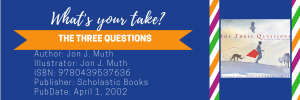by Seemi Aziz, University of Arizona, Tucson, AZ, and Melissa Wilson, Leeds Trinity University, Leeds, West Yorkshire, UK
This week Seemi and Melissa give their takes on a classic picturebook, The Three Questions, that helps children understand mindfulness.
This picture book, based on a story by Leo Tolstoy, tackles the very human quandary of how to be a good person. The main character, Nikolai, decides that this can be solved by asking three questions: “What is the best time to do things? Who is the most important one? And what is the right thing to do?” He asks his many animal friends, but their selfish answers don’t help. Nikolai hikes up a mountain to ask Leo, the old turtle for help. While there, Nikolai saves a hurt panda and her cub. With wise Leo’s guidance, Nikolai learns the answers to his three questions. The best time is now, the important one is who you are with this moment, and the right thing to do is what needs doing in the moment.
MELISSA: While this text is almost 20 years old, it seems tailor made for today. Like Nikolai, many of us are grappling with the three questions. Children and adults have had to put off plans, to isolate from the known, and to deal with unexpected bumps in the road. We don’t have a narrative for this this time. It is as if we are writing our story from scratch as we live it.
This is where mindfulness can help. We need to “…pay[ing] attention, on purpose, in the present moment, non-judgmentally”. Like Nikolai, we need to discover that the answers to life’s biggest questions are in the present, in action, directed towards those who are with us at this moment. This is not the mindfulness hawked in the Western world of self-care, meditation apps, and self-help books. This is the mindfulness from the ancients. We are here to do good. This “good” sometimes involves turning out attention from ourselves and our own suffering and being present to what and who is in front of us.
I have used this book with students in preschools through graduate schools as a jumping off point for discussions of meaning and social justice. This text, along with Muth’s other charming and philosophical books (they are all excellent!) can help give us a narrative structure we may be missing to deal with difficult times and our own angst.
SEEMI: I absolutely agree with the timeless nature of this text. I particularly appreciate the mindful aspect of the story. Muth’s art and written text compliment each other as did Santat’s in the previous book that we discussed. The soft tones of the watercolors lend to the messages conveyed within the narrative.
The significance to the moment one is in and the way one moves beyond the self and helps another who is in need provides satisfaction to the soul as it did for the characters in this book. What stood out to me was the amalgamation of human and animal characters and the manner in which it is the human who is asking the questions and the animals who hold the wisdom of ages to try to answer the questions. I have grown up reading and thinking about these thought-provoking questions based in the Eastern philosophies and religions.
Muth’s thoughtful texts have been a beacon of light for children to become thoughtful and critical thinkers. I particularly recommend Zen Shorts (2005) by him as well.
Title: The Three Questions
Author: Jon J. Muth
ISBN: 9780439537636
Publisher: Scholastic Books
PubDate: April 1, 2002
Throughout January 2021, Seemi Aziz and Melissa Wilson look at picturebooks that explore mindfulness to children. Check back each Wednesday to follow the conversation!
- Themes: Jon Muth, Melissa Wilson, Seemi Aziz, Three Questions
- Descriptors: Books & Resources, My Take/Your Take

